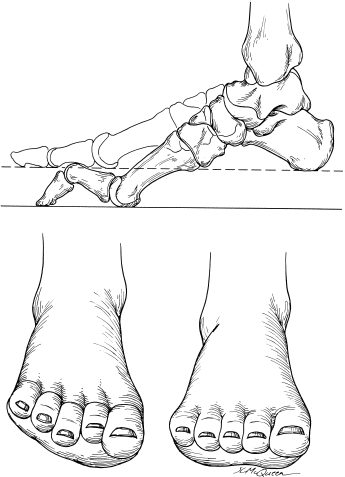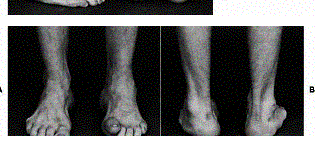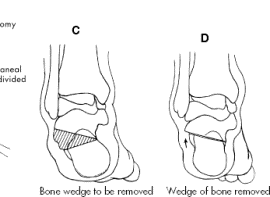Definition:
Abnormal elevation in longitudinal arch
Results in decreased plantar weight-bearing area
Places stress on metatarsal heads
Generalized stiffness of joints is common – decreased range of motion
Hindfoot often in varus position
Clawing of toes
Altered gait pattern
Increased pressure on lateral foot, then 1st metatarsal head
Etiology:
Charcot-Marie-Tooth disease
Congenital clubfoot
Anterior horn cell diseases
Poliomyelitis most common
Spinal cord tumor
Friedrich’s ataxia
Cerebral palsy
Muscular dystrophy
Sequelae of calf compartment syndrome
Idiopathic (commonly runs in families)
Anatomy:
Posterior cavus = calcaneus dorsiflexion pitch of 40° (Normal is 20°)
Anterior cavus = forefoot equinus (plantarflexed)Combined cavus = both calcaneus and forefoot components
Cavus foot Plantarflexed first ray in Charcot-Marie-Tooth Disease
Symptoms/Signs:
Compromised activity level secondary to increased pressure over metatarsal heads
Ambulation abnormalities in people with neurological disorders
Calf atrophy–associated with Charcot-Marie or clubfoot
Flexiblilty and location of deformity – hindfoot vs midfoot, lesser toes, plantar fascia
Coleman block test determines if heel varus is fixed, or flexible and due only to plantarflexed first ray
Imaging:
Bilateral weightbearing foot and ankle radiographs
Treatment:
Calcaneus lateral closing wedge osteotomy for correction of hindfoot varus position of cavus foot deformity
Conservative, nonoperative treatment is adequate for most cases of cavus foot:
Soft-soled shoes for mild deformity
Deep shoes for claw-toe deformities
Arch supports to decrease stress on metatarsal heads
oSurgical treatment involves correction of 1st metatarsal plantarflexion contracture, tight plantar fascia, and varus calcaneus deformity:
Plantar fascia release
Dorsiflexion osteotomy of 1st metatarsal
Lateral closing wedge osteotomy of calcaneus (Dwyer procedure, right)
More severe cases involve tendon transfers:
-Peroneus longus tendon to peroneus brevis
-Lengthening of posterior tibial tendon




